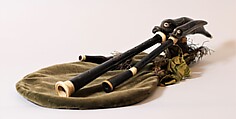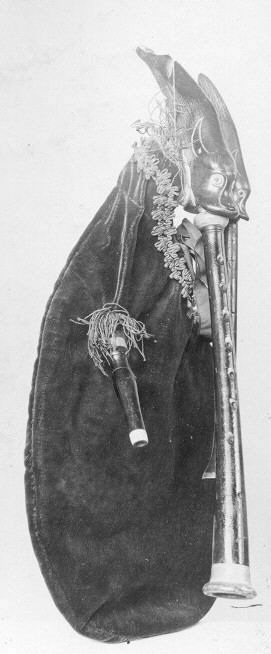‘Gaillard’ Musette
Possibly by P. Gaillard French
19th century
Not on view
This instrument is part of a specific type of bagpipes signed P.G. or ‘Gaillard’. This mark is often found on small ivory mouthblown pipes (see #89.4.865, #89.4.867, and #1994.296), but also on a range of dolphin-headed bagpipes such as this one (Montbel 2017:570-4).
From the dolphin heads emerge a melodic pipe and a parallel drone. The melodic pipe, stamped P.G. in an oval just below the thumb hole, is conical and is very similar to the Parisian cabrette (Blanc 1987), a popular instrument played by the community from Auvergne in the capital, animating the ‘bals musettes’ in the 19th and 20th century. The cyclindrical drone is parallel to the melodic pipe, as found habitually on the cabrette. The two parts of the drone, however, are made out of different pieces of woods and do not connect well. The leather bag has a green velvet cover trimmed with metallic woven passementerie. The cover is closed with a shimmering green ribbon, and the stock openings are adorned with fringes of thin metallic cords.
While the dimensions of this instrument fits those used by professional cabrette players in the 19th and early 20th century, the quality of the craftsmanship is not very high. The wood is painted dark, the lower part of the drone does not fit very well, and the drone bore is not centered. The drone has traces of wormwood that has been covered with the black paint, and the ivory stock for the dolphin heads is roughly cut. Despite these observations, bagpipe maker Bernard Blanc points out that this does not necessarily mean that the instrument was a copy (Blanc, 1984). It could have been part of the innovative trials that took place across the 19th century to create interesting instruments for a shifting market. In addition, the close resemblance of the melodic pipe to that of the functional cabrette, is too obvious to be ignored and it is possible that this instrument was made to be played in some form or another.
While another type of Gaillard musettes fit into a French eighteenth century look, these dolphin-head bagpipes fall more into the realm of fantastic animals. These instruments were probably commercial products most likely made for wealthy customers with a penchant for antique objects, which included musical instrument collectors (Libin 1997:170). To date, no bagpipe workshop with the name P.G. or Gaillard has been identified in France or Belgium. Eric Montbel suggest that Gaillard might not an instrument maker at all: this could be the stamp of an art dealer, a collector or a maker of fine objects (Montbel 2017:568).
(Cassandre Balosso-Bardin, 2023)
Technical description
Conical single chanter of blackened wood 385 mm, 7/1 holes, double cane reed (cane part missing), long staple;
1 drone in 2 sections 284 mm, cylindrical bore, reed missing (probably single cane reed);
Insufflation pipe with ivory mouthpiece 122 mm, leather flapper valve;
Leather bag covered with green velvet with gold braid, fringe, and green ribbons;
Horn chanter stock in 2 sections, carved with grotesque figures ('dolphins');
Cylindrical blowpipe stock of dark wood;
Ivory mounts.
References
Blanc, Bernard, 1984. Letter to Laurence Libin, Music Instrument file #89.4.864. Musical Instrument Department archives, Metropolitan Museum of Art, NY.
Blanc, Bernard, 1987. Notes, Music Instrument file #89.4.864. Musical Instrument Department archives, Metropolitan Museum of Art, NY.
Libin, Laurence, 1997. ‘Seeking the source of the Gaillard cornemuses’, Musique-Images-Instruments n° 3, p.168-177.
Montbel, Eric, 2017. ‘Les Musettes Gaillard des cornemuses d’ameublement’ in La Cabrette - Histoire et technique d’une cornemuse, ed. A. Ricros, E. Montbel, D. Perre. Riom: Amta, p.559- 585.
Due to rights restrictions, this image cannot be enlarged, viewed at full screen, or downloaded.
This artwork is meant to be viewed from right to left. Scroll left to view more.



